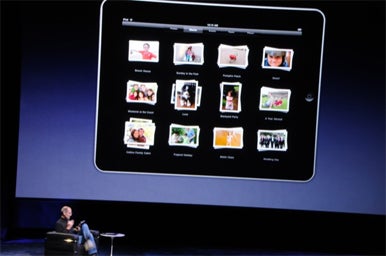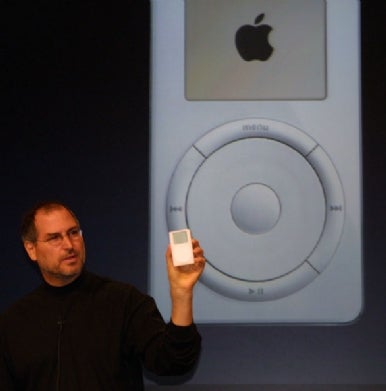There’s nothing like a Steve Jobs keynote address to get the tech world buzzing.
To get you ready for next week’s main event, Network World is taking a look back at the top five “Stevenotes” of the past decade that have changed the tech industry in ways that even Jobs’s own Reality Distortion Field could never have predicted.Jobs, a rare breed of tech CEO who also doubles as a compelling public speaker, has used his keynote platforms to introduce his company’s most important products for years now. Over the past decade alone, so-called “Stevenotes” have brought us the iPod, the iPhone and the iPad, which respectively brought portable digital music players, smartphones and tablet computers to the mass market. Jobs will also be on hand at the Worldwide Developers Conference next week to introduce Apple’s newcloud service, as well as the next generation of its iOS mobile operating system.
5. Apple switches to Intel processors (WWDC, 2005)
This may not have been the flashiest Stevenote out there, but Apple’s switch from IBM PowerBook processors to Intel chips in 2005 set up the company to be a long-term powerhouse in the computer market and paved the way for such high-performance brands as the MacBook Pro and the iMac Core Duo that were released in 2006. At the time Jobs said the switch from IBM to Intel basically came down to choosing a processor that could give users the best performance while consuming the lowest amount of power.
“When we look at Intel, they’ve got great performance, yes, but they’ve got something else that’s very important to us,” said Jobs. “Just as important as performance is power consumption.”
The marriage between Apple and Intel has been a success so far, as Apple laptops such as the MacBook Air and the MacBook Pro are among the top laptops recommended by Consumer Reports.
4. The App Store forever alters the mobile data landscape (iPhone Software Roadmap, 2008)
It didn’t seem like such a big deal at the time, but we now know that the introduction of the App Store marked the beginning of the mobile application craze that has altered how users consume mobile data on both smartphones and tablets. You see, it turns out that smartphone users don’t want to get data solely from their mobile Web browsers. Rather they also want to have a series of applications that are specifically tailored to perform functions such as updating sports scores, providing live stock quotes or delivering news feeds. The App Store has been a huge hit for Apple, as the store has delivered more than 10 billion downloaded apps over the past three years alone and has spawned imitators such as the Android Market and the BlackBerry App World.
How big has the mobile app market become? Earlier this year, research firm Gartner projected that mobile apps would generate $15.1 billion in revenue this year, a 190 percent increase from the $5.2 billion in revenue it generated last year. Gartner also says that mobile app downloads will reach 17.7 billion in 2011, more than double the 8.2 billion mobile apps downloaded in 2010. What’s more, Gartner doesn’t see mobile apps as just a fad, as it predicts that users will have downloaded a total of 185 billion mobile applications by the end of 2014, meaning users will have downloaded an average of more than 30 billion applications per year between 2008 and 2014.
3. The iPad makes tablets a must-have item (iPad launch, 2010)

Steve Jobs kicks back at the 2010 iPad unveiling.
“OK, so it’s basically a large iPhone.”
That was the reaction of many in the tech world when Steve Jobs first introduced the “magical” iPad tablet computer back in 2010. The tablet handily beat back the skeptics, however, as it went on to sell more than 3 million units in its first three months.
During his keynote, Jobs emphasized that the iPad would have to fill a niche somewhere between PCs and smartphones. In particular, Jobs emphasized the device’s ability to combine the mobility of a smartphone with a touchscreen large enough to deliver the full Web-browsing experience of a laptop.
“It’s the best Web-browsing experience you’ve ever had,” declared Jobs. “It’s phenomenal to see a whole Web page right in front of you and you can manipulate it with your fingers. It’s unbelievably great — way better than a laptop, way better than a smartphone.”
The iPad’s success seemingly caught the tech industry off guard as rival companies such as Motorola and Research in Motion have struggled to come up with a tablet capable of beating the iPad at its own game.
2. The iPod transforms how we listen to music (Apple press event, 2001)

Steve Jobs shows off the first iPod.
Anyone remember what a pain it used to be to buy an entire CD that contained one good song and 11 pieces of mediocre garbage? Yeah, we do too, which is why we’re thankful Apple came out with the iPod a decade ago.
The original iPod was able to hold 1,000 songs, was 0.2 inches thick and came with Apple’s own FireWire cable that let users import songs onto their iPods in a fraction of the time it would have taken using a USB cable. The smartest thing Apple did with the iPod, however, was to tightly integrate it into its iTunes interface and its iTunes Store, thus making Apple the go-to source for buying and managing music on the Web. This fit in well with Apple’s overall business strategy of making Apple products into entertainment hubs that consumers would use to store and access their music, movies, books and other media.
“This is a quantum leap because for most people [1,000 songs] is their entire music library,” explained Jobs. “You can take your whole music library with you right in your pocket.”
1. The iPhone sets new standards for mobile phones (Macworld Expo, 2007)
“Every once in a while a revolutionary product comes along that changes everything,” boasted Jobs during the iPhone’s launch in 2007. “Today Apple is going to reinvent the phone.”
While this keynote captured Jobs at his most insufferably cocky, we have to give him and his team at Apple credit for walking the walk. The iPhone was a smash hit right from the get-go as Jobs’ 2007 Macworld Expo keynote served notice that Apple was no longer content to keep playing second fiddle to Microsoft in the computing world.
What made the iPhone so successful? Well, it was a combination of factors, including a 3.5-inch multi-touch interface with pinch-to-zoom capabilities, an easy-to-use operating system and the first mobile phone Web browsing experience capable of approximating the full Web as it appears on PCs. Oh, and it could also make phone calls if you’re into that sort of thing.
In the four years since its debut the iPhone has remained the darling of the smartphone world, generating so much interest that smart journalists can rack up pageviews just by rounding up rumorsabout it once a week. Unless Steve Jobs somehow comes up with a device that lets users voluntarilyRapture themselves, it’s hard to see him topping the iPhone.


